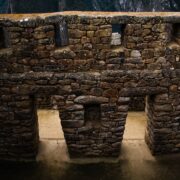
Discovering Hawaii’s Lava Tubes
Hawaii is known for its stunning natural beauty, from its pristine beaches to its lush rainforests. However, one of the most fascinating and unique features of the Hawaiian landscape is its lava tubes. Lava tubes are natural tunnels formed by flowing lava during volcanic eruptions. These underground passages are a significant part of Hawaii’s geology and have played a crucial role in Hawaiian culture and mythology.
Key Takeaways
- Hawaii’s lava tubes are natural formations created by flowing lava.
- Lava tubes play an important role in Hawaiian culture and mythology.
- Lava tubes are significant in Hawaiian geology and provide insight into the island’s volcanic history.
- Hawaii has various types of lava tubes, including skylights and collapsed tubes.
- The best places to explore lava tubes in Hawaii are in national parks and on private tours.
The Formation of Lava Tubes in Hawaii
Lava tubes are formed when molten lava flows from a volcanic vent and creates a tunnel-like structure as it cools and solidifies. The lava on the surface cools and hardens, forming a crust, while the molten lava continues to flow beneath it. As the lava drains out of the tube, it leaves behind a hollow tunnel.
Several factors contribute to the formation of lava tubes in Hawaii. The type of lava plays a significant role, with pahoehoe lava being more likely to form tubes than a’a lava. Pahoehoe lava has a smooth, rope-like texture that allows it to flow more easily and form tunnels. The slope of the terrain also affects the formation of lava tubes, as steeper slopes can create faster-moving flows that are more likely to form tubes.
The Role of Lava Tubes in Hawaiian Culture
Lava tubes have played an essential role in Hawaiian culture and mythology for centuries. They are believed to be the dwelling places of various gods and goddesses, and many ancient Hawaiian legends are associated with these underground passages. Lava tubes were also used by native Hawaiians as shelter during volcanic eruptions or as burial sites for their ancestors.
The spiritual significance of lava tubes to native Hawaiians cannot be overstated. They are considered sacred spaces and are often used for religious ceremonies and rituals. Many Hawaiians believe that these underground tunnels connect the physical world with the spiritual realm, making them a vital part of their cultural identity.
The Importance of Lava Tubes in Hawaiian Geology
| Importance of Lava Tubes in Hawaiian Geology |
|---|
| 1. Protection of fragile ecosystems |
| 2. Preservation of cultural sites |
| 3. Study of volcanic activity |
| 4. Exploration of unique geological formations |
| 5. Understanding of lava flow dynamics |
| 6. Potential for future human habitation |
Lava tubes are not only significant in Hawaiian culture but also play a crucial role in the geology of the islands. They contribute to the unique volcanic landscape of Hawaii and have shaped the formation of the islands over millions of years. Lava tubes act as conduits for lava, allowing it to flow from the volcanic vent to the ocean or other areas.
Scientific research has been conducted on lava tubes in Hawaii to better understand their formation and how they contribute to the overall geology of the islands. This research has provided valuable insights into volcanic activity and has helped scientists predict and mitigate the impact of future eruptions.
The Different Types of Lava Tubes Found in Hawaii
There are several different types of lava tubes found in Hawaii, each with its unique characteristics. The most common type is a simple tube, which is a straight, cylindrical passage formed by flowing lava. These tubes can range in size from a few feet to several miles long.
Another type of lava tube found in Hawaii is a branched tube. These tubes have multiple passages that branch off from the main tunnel, creating a complex network of interconnected tunnels. Branched tubes are often formed when multiple lava flows converge and create a more extensive system.
Lastly, there are skylights, which are openings in the roof of a lava tube that allow light to enter. Skylights are formed when the roof of a tube collapses or is eroded away, exposing the interior of the tunnel to the surface.
The Best Places to Explore Lava Tubes in Hawaii
Hawaii offers several excellent locations for exploring lava tubes. One of the most popular destinations is Hawaii Volcanoes National Park on the Big Island. The park is home to numerous lava tubes, including the Thurston Lava Tube, which is easily accessible and offers a unique opportunity to walk through an underground tunnel.
Another great location for exploring lava tubes is the Kilauea Caverns of Fire on the Big Island. This privately-owned attraction offers guided tours of a lava tube system that stretches for over 30 miles. Visitors can explore the tunnels and learn about the geology and history of the area.
On Maui, visitors can explore the Ka’eleku Caverns, which is a lava tube system that stretches for over half a mile. The caverns offer guided tours that provide insight into the formation and significance of lava tubes in Hawaiian culture.
The Unique Characteristics of Hawaii’s Lava Tubes
Hawaii’s lava tubes have several unique features and characteristics that make them a fascinating destination for exploration. One of the most striking features is the intricate patterns and textures on the walls of the tunnels. These patterns are formed by the cooling and solidification of the lava, creating beautiful formations that resemble waves or ropes.
Another unique characteristic of Hawaii’s lava tubes is the presence of stalactites and stalagmites. These formations are created when minerals in the water seep into the tunnels and slowly build up over time. The result is a stunning display of natural beauty that adds to the allure of exploring lava tubes.
The Wildlife and Plant Life Found in Hawaii’s Lava Tubes
Despite the harsh conditions, Hawaii’s lava tubes are home to a surprising variety of wildlife and plant life. Many organisms have adapted to survive in this unique environment, making it a haven for specialized species.
One example is the Hawaiian blind cave spider, which is found exclusively in lava tubes. This spider has lost its eyesight due to living in complete darkness and has developed elongated legs to navigate its surroundings. Other species, such as cave crickets and blind shrimp, have also adapted to life in lava tubes.
In terms of plant life, mosses and ferns are often found growing on the walls of lava tubes, taking advantage of the moisture and nutrients available. These plants add a touch of greenery to the otherwise barren landscape and provide a habitat for other organisms.
The Challenges of Exploring Lava Tubes in Hawaii
Exploring lava tubes in Hawaii comes with its fair share of challenges. The underground environment can be dark, damp, and uneven, making it difficult to navigate. It is essential to have proper lighting and footwear to ensure safety while exploring.
Another challenge is the potential for rockfalls or collapses within the lava tubes. Over time, the roofs of the tunnels can become unstable, posing a risk to visitors. It is crucial to stay alert and be aware of your surroundings when exploring lava tubes.
Additionally, the high humidity and lack of ventilation in lava tubes can make them uncomfortable for extended periods. It is essential to bring plenty of water and take breaks when needed to avoid dehydration or overheating.
The Future of Hawaii’s Lava Tubes and Conservation Efforts
As Hawaii’s popularity as a tourist destination continues to grow, it is crucial to prioritize the conservation of its natural resources, including lava tubes. Efforts are being made to protect and preserve these unique geological features for future generations.
Conservation organizations and government agencies are working together to establish guidelines for responsible exploration of lava tubes. These guidelines include staying on designated paths, not removing any rocks or artifacts from the tunnels, and respecting the cultural significance of these sites.
By raising awareness about the importance of lava tubes and implementing conservation measures, we can ensure that these unique geological features continue to be enjoyed by visitors while preserving their natural beauty for years to come.
FAQs
What are lava tubes?
Lava tubes are natural tunnels formed by flowing lava during volcanic eruptions. They are typically found in areas with volcanic activity and can range in size from small crawl spaces to large caverns.
Where are the lava tubes in Hawaii?
Hawaii has several lava tubes, including the Thurston Lava Tube in Hawaii Volcanoes National Park, the Kazumura Cave System, and the Kaumana Caves.
Are lava tubes safe to explore?
Exploring lava tubes can be dangerous and should only be done with caution and proper equipment. Some lava tubes may have unstable ceilings or floors, and there may be hazards such as sharp rocks or low oxygen levels.
What should I bring when exploring lava tubes?
It is recommended to bring a flashlight or headlamp, sturdy shoes with good traction, and a helmet. It is also important to bring plenty of water and to let someone know where you are going and when you plan to return.
Can I explore lava tubes on my own?
It is not recommended to explore lava tubes on your own, as they can be dangerous and unpredictable. It is best to go with a guide or a group of experienced explorers.
What can I expect to see in lava tubes?
Lava tubes can have unique geological formations, such as stalactites and stalagmites, as well as interesting colors and textures on the walls and ceilings. Some lava tubes may also have small pools of water or streams running through them.



















Your point of view caught my eye and was very interesting. Thanks. I have a question for you.